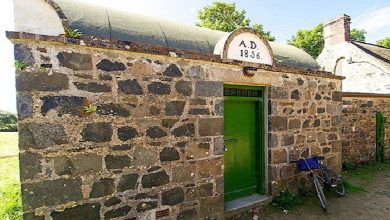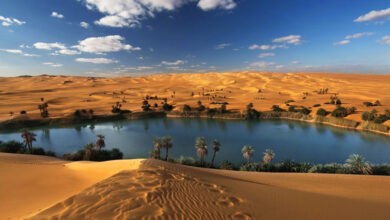Mysterious ‘alien’ stone statues of Nuku Hiva on an island in Polynesia
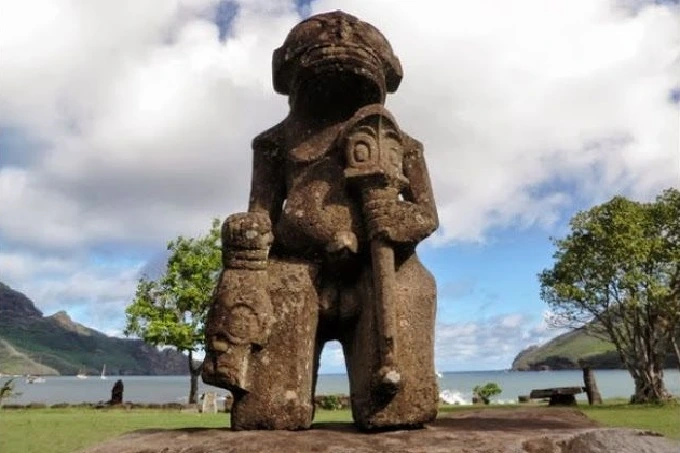
Nuku Hiva is the largest island in Polynesia. In addition to being the largest among the Marquesas Islands, it is especially famous for its mysterious stone statues. They are scattered throughout the island. Most of them are located in a small village called Temehea Tohua.
Scientists say that all these strange monuments were created in the period from the 11th to the 14th century. It is possible that these statues are the ancient deities of the Nukuhivans. A deeper study of their origin plunges into the extremely interesting history and incredibly rich culture of Nuku Hiva, revealing a lot of secrets.
The legend of the origin of Nuku Hiva
The Nukuhivans, like any nation, have their own legends about who they are and where they came from. These stories tell how the supreme deity Ono once decided to please his beloved wife. He said that in just one day, he would create for her the most beautiful home on Earth.
He collected mountains of stones and Earth, and poured out of them into the Marquesas Islands. Each island is some part of this house. Nuku Hiva, for example, is a rooftop. Wa Huka, one of the islands near Nuku Hiva, is the remains of materials left after the completion of the majestic creation of the god Ono.
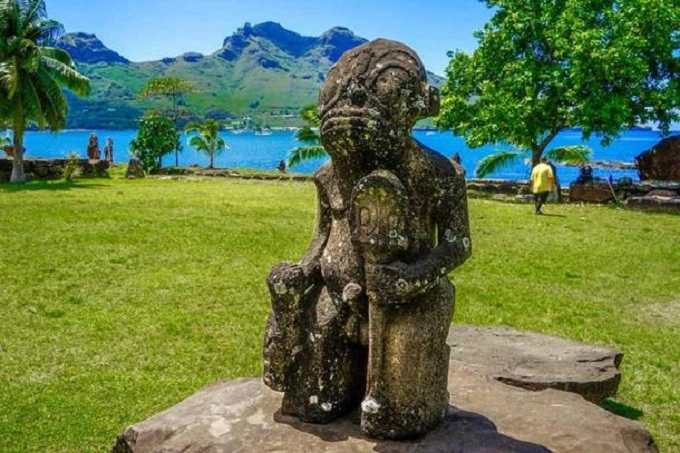
Historians claim that the first people appeared on the island two millennia ago. They arrived here from western Polynesia, in particular from the island of Samoa. In ancient times, Nuku Hiva was divided into two separate provinces: Te Li and Tai Pi. At first, almost 100,000 people lived here.
In such a limited space, this made it difficult both to obtain food and build housing. The main food items were fish and fruits. Many believe that due to the lack of food, cannibalism flourished on the islands, but historians have not found confirmation of this.
Nuku Hiva has existed and flourished for many centuries. In 1595, the Spanish explorer Alvaro de Mendaña de Neira arrived here. Two centuries later, the famous James Cook visited the island. After that, Nuku Hiva became famous in Europe. Commerce, shipping, and whaling began to develop.
After the arrival of Europeans, epidemics of various diseases began to rage on the islands, especially typhoid fever. Because of this, the population decreased in a short time by almost 90%! At the end of the 19th century, the French government became concerned about the preservation of the indigenous population. Thanks to medical care and appropriate vaccinations, the complete extinction of the Nukukhivans was stopped. In the middle of the 20th century, France declared Polynesia its an overseas colony.
This allowed the Polynesians to elect their representatives to both the French National Assembly and the French Senate. Of course, this did not make any special changes to the French government. Nukuhivans strive for independence but, at the same time, do not want to lose touch with France. Compared to the past, the population has been greatly reduced. In 2017, the population of Nuku Hiva was approximately 3,210.
Modern Polynesian paradise
Nuku Hiva boasts a very lush landscape. The island has incredibly luxurious vegetation, golden sandy beaches, cozy bays, and beautiful valleys. Each side of the island has its own unique topography. In the north are deep bays, and in the east are most of the villages and marinas for boats. In the center of Nuku Hiva, there are plateaus that serve as local pastures for grazing. The main source of freshwater is the Waipo Falls. This is the largest waterfall in Polynesia.
Modern Nukuhivans live off natural resources and tourism. The food consists of a variety of fruits and vegetables. Of the cereals, it is mainly rice, but wheat is also present, from which French bread is baked. Meat is also available, but it is limited mainly to goat meat on the menu. Much more fish is consumed.
Throughout the island, there are ancient stone statues of a very strange look. In ancient times, here, as in many places on the globe, they worshiped numerous pagan deities. Now Nukuhivans are mostly Christians. It is clear that Christianity was brought to the island by European missionaries. Nuku Hiva has a lot of temples. The largest and most famous is the Cathedral of Our Lady of the Marquesas Islands. The church is located near the capital of the island, Taiohae.
Mysterious statues of Nuku Hiva: deities or aliens from other worlds?
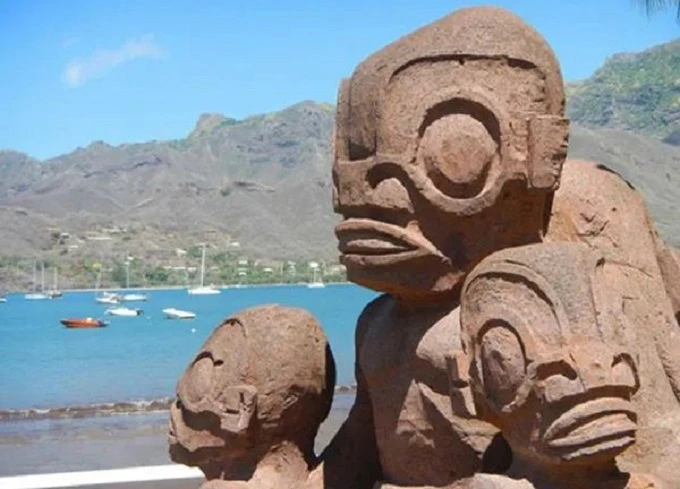
Since the beginning of the 20th century, archaeologists have begun to carefully study the mysterious stone sculptures of Nuku Khiva. Experts wanted to know more about the ancient roots of the island. In the course of research and excavations, they were able to understand when and where the first people arrived here. They were Western Polynesians who came here around 150 BC. Scientists also discovered that the main occupation of the ancient Nukuhivans was the manufacture of pottery and stone processing.
The ancient statues of Nuku Hiva are in remarkably excellent condition considering they were probably created around the 11th century. The sculptures have been preserved to the smallest detail, they have few chips and cracks. This speaks of the skillful craftsmanship of the ancient Nukuhivans. The sculptures are made from a mixture of red clay and volcanic rock. All this is still present on the island in fairly large quantities.
All statues are completely different. They depict various living beings. A feature of these monuments is that they all have some similar features: large heads, giant eyes, squat bodies, and short limbs. Some of them are carved in traditional clothing, while others are completely absent. Perhaps this is a different artistic style, or perhaps the effect of time and weather conditions.
The largest sculpture was named after the island – Nuku Hiva. The locals call these monuments tiki. Each of them serves a specific purpose. Some are meant to heal and bless. Others can give wisdom or help in love. There are those that are considered beings-protectors. They are designed to protect the island from military aggression from outside.
Ufologists, of course, argue that these monuments are evidence of the contact of the Nukukhivans with aliens. In their opinion, small reptilian bodies with large eyes can only belong to aliens from other planets. They even claim that the clothing carved on the statues is actually a spacesuit.
However, historians say it is far more likely that they simply represent a particular and prevalent art style at the time. This is supported by similar stone statues of deities found around the world in dozens of other ancient cultures with similar proportions. Few people worship them today. They believe that statues can grant wishes if treated with due respect.
Save Nuku Hiva
Excavations are still ongoing in Nuku Hiva. Scientists are eager to learn as much as possible about the fantastically rich ancient culture of the island. Constantly, archaeologists discover more and more new monuments, experts complement the already rich history of the island. The island authorities are also giving great support for further preserving and protecting the discoveries made during these excavations, especially the ancient stone deities found.

Last year, the authorities of the Marquesas Islands applied for the inclusion of Nuku Hiva in the UNESCO World Heritage List. This angered the locals. They believe that they can take care of their cultural heritage themselves. In addition, many sculptures are found in Polynesian communities that do not want the government to stick its nose into their lands. Some natives think that France wants to establish the islands as part of the French heritage in taking such a step.
According to the locals, this is unacceptable because they existed long before the Europeans came here, and France established its power.
Despite this, all parties agree that the statues of Nuku Hiva are an incredibly important aspect of the culture of the Marquesas, and they need to be protected. Culture must be preserved for future generations. This is a precious heritage and should not be allowed to disappear from the face of the Earth. Archaeologists are constantly trying to reveal the secrets of history.



